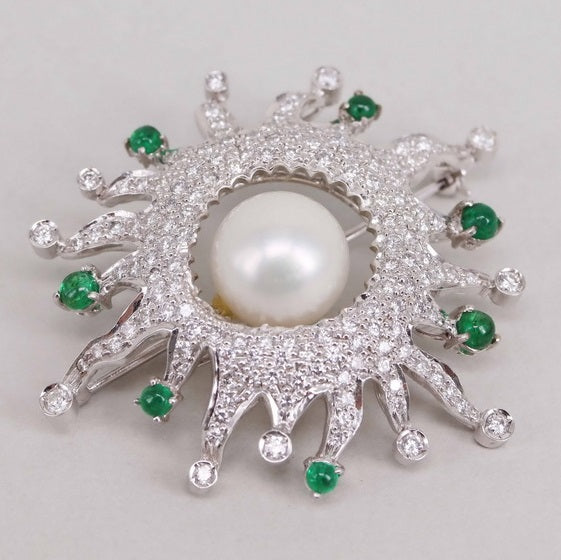Smooth and sensual, pearls have been desired for centuries for their beautiful luster and luminous glow. Pearls are cultured all over the world in both saltwater and freshwater. The type of water that nurtures the pearl growing mollusk makes a big difference in the resulting gem, let’s find out why.
Saltwater Pearls
Saltwater pearls are cultivated in ocean coastal areas and they tend to be high quality. To grow a pearl, skilled technicians insert a teeny round bead into the oyster, which will help a pearl to form in that shape. The bead irritates the oyster and it secretes nacre around the intruder to soothe the annoyance it causes. Layer upon layer of nacre forms around the bead creating a cultured pearl. Saltwater pearls tend to be in the water anywhere between one and three years, allowing the pearl to grow bigger and to become more lustrous. The cold saltwater slows the metabolism of the oyster allowing for denser nacre to grow, creating a high luster. The shiny luster found on saltwater pearls is one of the attributes that makes them higher quality and much pricier than their freshwater counterparts.
Akoya Pearls

Akoya cultured pearls are probably the best known pearl variety and they are what generally comes to mind when we think about pearls. Coming mostly from Japan, Akoya pearls tend to be round with a white or creamy color. Mikimoto is a famous producer of Akoya pearls, which are also cultivated in the Mississippi River. These pearls form in the Pinctada Fucata oyster, also known as an Akoya oyster, which is a small oyster. Akoya pearls are known for their round shape and are generally smaller than other saltwater pearls. These pearls typically spend 12 to 18 months in the water growing.
South Sea Pearls

South Sea cultured pearls are large and can either be white or golden in color. Forming in the Pinctada Maxima oyster, also called a white lipped oyster, South Sea pearls are grown in waters around Australia, Indonesia and the Philippines. Pinctada Maxima oysters, which tend to be big, stay in the water for two or three years, resulting in some of the largest pearls on the market.
Tahitian Pearls

Tahitian cultured pearls are also very large and are black or gray and occasionally brown in color. One of the traits that makes these pearls really special is that they tend to have an overtone color of pink, purple, blue or green. Tahitian pearls, form in the Pinctada Margaritifera oyster, also called a black lipped oyster, in lagoons around French Polynesia, which includes the island of Tahiti. It takes around two years for a Tahitian pearl to be fully formed.
Freshwater Pearls

Freshwater pearls are cultivated in rivers, lakes and even ponds. Freshwater pearls grow in a type of mussel called Hyriopsis Cumingii, or freshwater mussel, they also grow in Hyriopsis Schlegelii and Cristaria Plicata mussels. Freshwater pearls tend to be less expensive than their saltwater counterparts.
Lake Biwa near Kyoto in Japan was a large producer of freshwater pearls, peaking during the 1980s, until the supply diminished due to water pollution. Freshwater pearls have also been cultivated in the Mississippi basin in the United States. After the drop in production in of Lake Biwa pearls, China became the biggest producer of freshwater pearls.
One big difference between saltwater and freshwater pearls is that each freshwater mussel can produce numerous pearls, up to 50 per mussel, providing an abundant supply. Freshwater pearls are cultured in the same way as saltwater pearls, nucleated by a trained professional, but instead of a round bead, they are cultured with mantle tissue from a like mussel, which then triggers the mussel to create nacre to stop the irritation from the intruding element.
Made of mostly nacre, freshwater pearls are very durable and generally are not round. Shapes include flat to oval and even some that have the same form as cornflakes, such as Keshi pearls. Freshwater pearls are also fun because they come in a variety of natural colors from pink and white to lavender and peach.
Every jewelry wardrobe should include pearls, with so many types to choose from and so many styles, there is a pearl for everyone at a price point for every wallet.
Top of Page: Diamond, cultured pearl, emerald and 18-karat white gold brooch.
Cultured pearl, black diamond and 18-karat gold earrings, signed De Grisogono; Diamond, South Sea cultured pearl and 18-karat gold earrings; Diamond, Tahitian pearl and platinum brooch, signed Mikimoto; Edwardian natural freshwater pearl, diamond 18-karat gold and platinum brooch, signed Dreicer.
Authored by Amber Michelle

